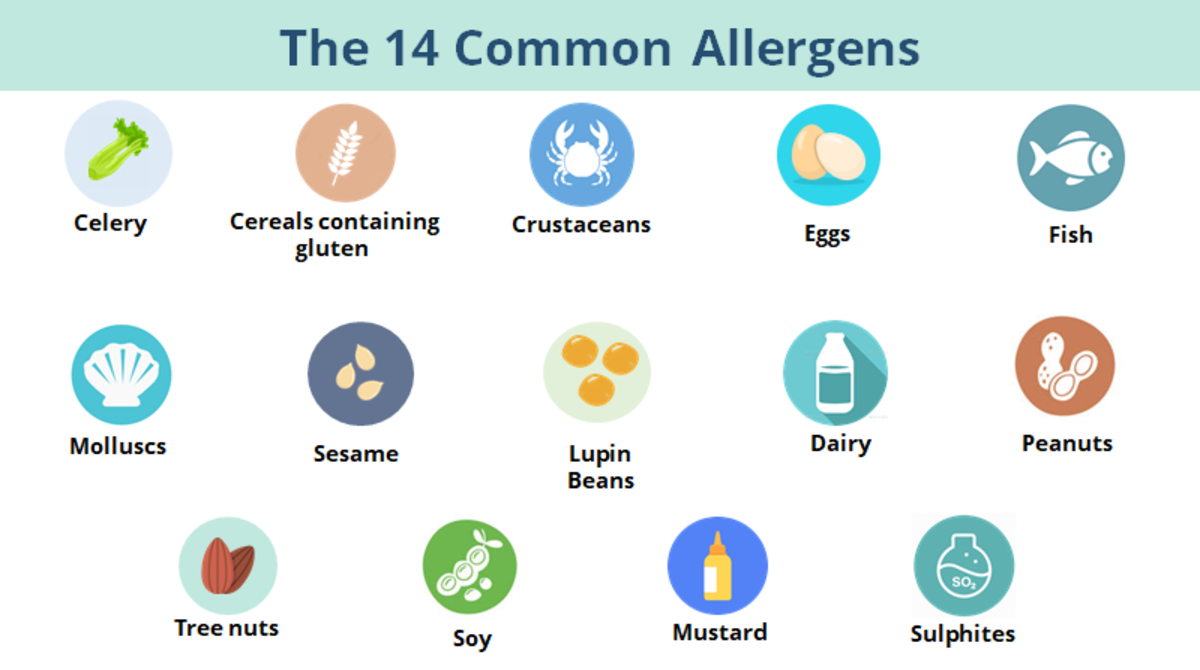How to declare food allergens on food products correctly?
August 24, 2022

Any severe reaction to food that elicits an immunological response is defined as a food allergy. In today’s world food allergies are very common with their prevalence spreading to many countries around the globe, affecting most children (4-6%) compared to adults (1-2%). The symptoms usually begin within a few minutes to up to an hour of consumption of food containing the allergen substance. These symptoms range from mild to life-threatening reactions having life-long risks.
Food is a complex mixture of nutrients including carbohydrates, proteins, fats, vitamins and minerals. All these nutrients are essential for our daily activities and well-being. Indian diet comprises several ingredients such as vegetables, pulses, rice/wheat, and spices and delivers essential nutrients. But, everyone cannot eat everything as every individual’s immune system responds differently to different food products. Proteins in foods are often misunderstood to be antigens (toxins/foreign objects) by the immune system and trigger abnormal responses. These abnormal responses are called food allergies and substances in foods that provoke responses are food allergens. More than 160 food materials are identified as allergenic, including milk, egg, wheat, fish, peanut, chickpeas, rice, black gram, mustard etc.
Why is allergen information considered important?
With such an adverse health impact caused due to intake of a simple food molecule, allergen information becomes highly important. Also, food allergenicity has no cure with strict management and avoidance of food allergens being the only measure. Therefore, allergen information is key in informing consumers about the presence of allergens in packaged food, so that consumers can make smart health choices for themselves.

Prevalence of Food Allergy
Prevalence of food allergy is higher in preschool children and most of the kids outgrow their allergy as they grow up. The annual incident rate of sensitization to food allergens such as egg, wheat, milk and soy decreases from 10% at one year of age to 3% at six years of age. Food allergies related to processed foods are important health problems in industrialized countries. Nearly 2% of the adult population and 8% of children are suffering from food allergies and overall the symptoms are exhibited among 22% of the general population. There is no food processing tool for completely eliminating allergenicity and avoidance of such food is the only cure for people who are sensitive. Ingredient labels on processed/packaged food inform consumers about what it is made of (food ingredients) and become a crucial tool in preventing such food products on sensitive individual’s plates. Though 160 foods can trigger allergic reactions in people, foods at higher risk of allergy are identified depending on the diet in the region and incidents of allergy. Eight food ingredients are causative agents for more than 90% of food allergies in the US and 14 ingredients are categorized as higher risk in the EU. Rice is not an allergen of concern for the US and EU but is a major allergen in Japan. The research was conducted on the prevalence of food allergy to eggplant in rural and urban Mysore city and confirmed food allergy in 0.8% of tested individuals. Chickpeas and Bengal gram are also considered to trigger allergic reactions in Indians. It is difficult to estimate the prevalence of food allergy in India as most of the incidents go unreported.
List of important food allergens
The back panel of a packaged food label contains the allergen information stating the presence of allergens contained in the product. The Codex Alimentarius Commission in its regulations of ‘General Standard for the Labelling of Prepackaged Foods’ has clearly defined eight food groups as major allergens which are to be declared on the pack.
Cereals containing gluten; i.e., wheat, rye, barley, oats, spelt or their hybridized strains and products of these;
Crustaceans and products of these;
Eggs and egg products;
Fish and fish products;
Peanuts, soybeans and products of these;
Milk and milk products (lactose included);
Tree nuts and nut products; and
Sulphite in concentrations of 10 mg/kg or more.
FSSAI (Food Safety and Standards Authority of India) and US FDA (Food and Drug Administration) also states these eight food groups as allergens to be mandatorily listed on the pack. On the other hand, the European Union in its regulations has stated an extensive list of 14 foods as allergens including celery, lupin, mustard and sesame seeds apart from the eight allergens mentioned by Codex Alimentarius.
Precautionary Allergen Labels
Besides allergens from direct foods, cross-contamination during food production can also cause products to get contaminated with allergies at any point in the food chain. Shared equipment can cause allergenic ingredients to enter foods. Since there is no certainty about the amounts of allergens that can cause reactions, food manufacturers in several countries now use precautionary allergen labels (PAL) which state that the ingredients ``may contain '' allergenic foods and name the possible allergens in their food products. Since there is no processing tool that can fully remove allergens, the labelling of ingredients is most important to keep consumers safe and prevent health problems.
Several countries have issued food labelling regulations that mandate the precautionary/warning statement regarding the possible allergen present in the food to alert the consumer. North American countries such as the US and Canada, South American countries such as Brazil and Chile, Asian countries such as Malaysia, Japan and Singapore, and European Union have such labelling regulations. China too joined the group in 2012.
How to read & interpret allergen information?
As we now know that allergens are critical for a small population, reading them correctly and interpreting them is as vital. Here are some of the points to note while reading an allergen list.
The allergen information is usually present after the ingredient list or just below the nutrition information.
There are about eight major food groups identified as potential allergens.
The allergen list is based on the kind of ingredients that goes into making the product.
It is essential to know the type of food group/allergen that has an allergic reaction in your body so that you can make the right choice of food based on the allergen information.
If you find out that the list of allergens given by the manufacturer on the label is not extensive or lacks certain allergens, you can immediately contact the concerned Food Manufacturer about the same or inform FSSAI about it.
Also Read - How to choose a food product if you have a Food Allergy?
Awareness of Food Allergy in India
India lacks sufficient levels of data on food allergies, and their prevalence and lacks consumer awareness. Most people still do not consider food allergies to be a major problem and overlook the potential health impact they can have on a person. India being a culturally dynamic country, has varied food options/cuisines which becomes all the more imperative for a high-risk person to know what ingredients are present. Hence, FSSAI has recognised this issue at hand and mandated the listing of eight food groups as allergens to be mentioned on every packaged food.
As India is progressing in its economy, the level of food allergies is increasing steadily due to lifestyle modifications and urbanisation. Therefore, realising the importance of allergen information is crucial along with public awareness and education.
Get Regulatory Compliant Food Labels in under 5 Minutes!
References
1. International Food Safety Authorities Network (INFOSAN). INFOSAN Information Note No. 3/2006 – Food Allergies. Retrieved from International Food Safety Authorities Network (INFOSAN) (who.int)
2. Food Safety Helpline. (February, 2016). Rising food allergies could lead to mandatory allergen labelling. Retrieved from https://foodsafetyhelpline.com/rising-food-allergies-could-lead-to-mandatory-allergen-labelling/
3. U.S. Food and Drug Administration (FDA). What You Need to Know about Food Allergies. Retrieved from What You Need to Know about Food Allergies | FDA
4. Arora. I (December, 2019). Do you have food allergies? Here’s an alternative for you. Financial express. Retrieved from https://www.fssai.gov.in/upload/media/FSSAI_News_Allergies_Financial_02_12_2019.pdf
5. JOINT FAO/WHO FOOD STANDARDS PROGRAMME CODEX COMMITTEE ON FOOD LABELLING, Forty-fifth Session, Canada (2019, May 13 – 17). Retrieved from www.fao.org/fao-who-codexalimentarius/sh-proxy/en/?lnk=1&url=https%253A%252F%252Fworkspace.fao.org%252Fsites%252Fcodex%252FMeetings%252FCX-714-45%252Fdocuments%252Ffl45_08e.pdf
6. FAO/WHO Food Standards. Codex Alimentarius. General standard for the labelling of prepackaged foods. Codex Stan 1-1985 (Rev. 1-1991). Available at: http://www.codexalimentarius.net
7. Food Standards Agency. Allergen labelling for food manufacturers. Retrieved from Allergen labelling for food manufacturers | Food Standards Agency
8. Gangal, S. V., & Malik, B. K. (2003). Food Allergy-How Much of a Problem Really is This in India? Journal of Scientific and Industrial Research. 62, 755-765. Retrieved from JSIR 62(8) 755-765.pdf (niscair.res.in)
9. Rathi, A., & Sharma, S. (2017). Changing Allergy Patterns in India. Commentary Article Mathews Journal of Immunology & Allergy, 1. Retrieved from changing-allergy-patterns-in-india.pdf (mathewsopenaccess.com)

Olivia Crasto (MSc in Food Processing & Preservation)
Olivia is a Learner for Life, Eco enthusiast and loves to experience nature and its beauty
